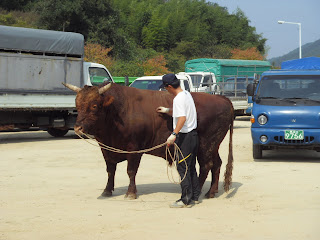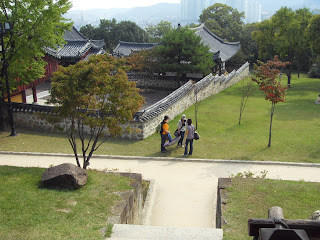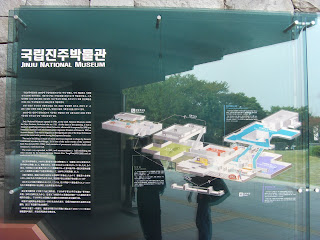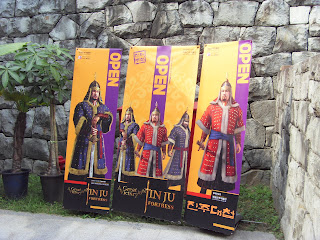Day 45 ( Jinju Trip Day 2 )
4th October 2008, we are on our way to explore more in Jinju! Came out of Jimjibang after another experience of naked bath, had a quick lunch before proceeding to the Jiju Bullfighting Competition!
Saw the beautiful Namgang Bridge once again!
 Then something caught our sight!! If i'm not mistaken, they're having fireworks in the morning?!?!?! LOL!! A mini one perhaps.. :P
Then something caught our sight!! If i'm not mistaken, they're having fireworks in the morning?!?!?! LOL!! A mini one perhaps.. :P



 Along the way to take the free shuttle bus~
Along the way to take the free shuttle bus~
 Finally reached the Bullfighting Stadium!
Finally reached the Bullfighting Stadium! The provincial city has a tradition of bullfighting, considered to be the longest one in Korea. Jinju bullfighting, now one of the city's representative folklore events, has originated from an occasion of bullfighting celebrating Silla Kingdom's victory over a war against Beckjae Kingdom. The records on the victory and bullfighting are kept at the Louvre Museum in Paris. A bullfighting competition is being held once every year to keep intact the bullfighting tradition to an original one, during Jinju Namgang Yudeung Festival.
The provincial city has a tradition of bullfighting, considered to be the longest one in Korea. Jinju bullfighting, now one of the city's representative folklore events, has originated from an occasion of bullfighting celebrating Silla Kingdom's victory over a war against Beckjae Kingdom. The records on the victory and bullfighting are kept at the Louvre Museum in Paris. A bullfighting competition is being held once every year to keep intact the bullfighting tradition to an original one, during Jinju Namgang Yudeung Festival. 

 Karen trying to take a photo!
Karen trying to take a photo! Joseph and Li Shi~!
Joseph and Li Shi~! That ends our Jinju trip! It was quite a nice experience, but very very tiring.. haha!! Perhaps it's because we didn't really sleep well.. but all in all, we enjoyed the fireworks and the lantern festival! Now let's get back to Busan for our studies again.. Boo!!
That ends our Jinju trip! It was quite a nice experience, but very very tiring.. haha!! Perhaps it's because we didn't really sleep well.. but all in all, we enjoyed the fireworks and the lantern festival! Now let's get back to Busan for our studies again.. Boo!!
Saw the beautiful Namgang Bridge once again!

 Then something caught our sight!! If i'm not mistaken, they're having fireworks in the morning?!?!?! LOL!! A mini one perhaps.. :P
Then something caught our sight!! If i'm not mistaken, they're having fireworks in the morning?!?!?! LOL!! A mini one perhaps.. :P


 Along the way to take the free shuttle bus~
Along the way to take the free shuttle bus~
 Finally reached the Bullfighting Stadium!
Finally reached the Bullfighting Stadium! The provincial city has a tradition of bullfighting, considered to be the longest one in Korea. Jinju bullfighting, now one of the city's representative folklore events, has originated from an occasion of bullfighting celebrating Silla Kingdom's victory over a war against Beckjae Kingdom. The records on the victory and bullfighting are kept at the Louvre Museum in Paris. A bullfighting competition is being held once every year to keep intact the bullfighting tradition to an original one, during Jinju Namgang Yudeung Festival.
The provincial city has a tradition of bullfighting, considered to be the longest one in Korea. Jinju bullfighting, now one of the city's representative folklore events, has originated from an occasion of bullfighting celebrating Silla Kingdom's victory over a war against Beckjae Kingdom. The records on the victory and bullfighting are kept at the Louvre Museum in Paris. A bullfighting competition is being held once every year to keep intact the bullfighting tradition to an original one, during Jinju Namgang Yudeung Festival. 

 Karen trying to take a photo!
Karen trying to take a photo! Joseph and Li Shi~!
Joseph and Li Shi~!
Took some videos in the Bullfighting Stadium!! Enjoy with us!!
More pictures!!






 Took a real close up shot of the bull!! nice job camara!
Took a real close up shot of the bull!! nice job camara!








 And ahead of us is the Yeongnam Pojeongsa Gate!
And ahead of us is the Yeongnam Pojeongsa Gate!
( Gyeongnam Provincial Cultural Assets Material No. 3 )



More pictures!!






 Took a real close up shot of the bull!! nice job camara!
Took a real close up shot of the bull!! nice job camara!







Haha.. the weather is hot! We get off from the Bullfighting Stadium rather quickly and proceed to enter the Jinjuseong Castle! Saw some celebration along the street:
 Yup!! This is the Jinjuseong Castle ( Historical Monument No. 118 )
Yup!! This is the Jinjuseong Castle ( Historical Monument No. 118 )

 Yup!! This is the Jinjuseong Castle ( Historical Monument No. 118 )
Yup!! This is the Jinjuseong Castle ( Historical Monument No. 118 )Jinjuseong Castle is famous for having one of the three "Great Victories" made during the Japanese Invasion in 1592. The General Kim Si-min won a victory at this castle, repulsing Japanese invaders. And the next year, in the second Jinjuseong Castle Battle, about 70,000 militiamen and government troops resisted to the last to die for their country. The castle, well preserved and renovated to its original state, is one of Jinju City's representative tourist spots because it is in perfect harmony with the scenic landscape of the Namgang River.
Took a picture at the Gongbukmun ( Gate )
Gongbukmun has the meaning in its name that they always respect the King who is in the Northern direction. This gate was rebuilt on May 1, 2002 with 2 storied structure.
This statue was unveiled on January 1, 2001, to succeed to the loyalty of General Kim, Si-min.
General Kim Shi-min, who led his troops to victory in one of the fiercest battles during the 1592 Japanese invasion of Korea, was born in 1554 in Byeongcheon, Chungcheongnam-do province. He was of a clan origination in Andong and his father, Kim Chung-gap, was a government official. He passed the state military service examination in 1578 and, after working in the Military Training Administration, was posted to Jinju as an aide to the magistrate in 1591.
When the magistrate of Jinju died of an illness when Japan invaded Korea in the 4th lunar month of 1592, Kim undertook the magistrate's job, encouraging the townspeople to construct walls, moats and other fortifications and organizing the military command and supplying weapon. He won battles at Sacheon, Goseong, Jinhae and Geumsan and was promoted to senior magistrate.
On the fifth day of the 10th month of the same year, a 20,000-strong Japanese army attacked Jinju. With only 3,800 soldiers under his command, Kim fought valiantly for six days and successfully defended Jinju town in what came to be known as the Great Battle of Jinju.
The general was hit in the head by an enemy bullet during the battle and later died from the wound in Jinju Town, worrying to his last minute about the future of his country. He was 39 years old.
Before his death, Kim was promoted to Military Commander of Gyeongsang-u-do province. If only he had not died prematurely, perhaps Jinju would not have fallen to the enemy the next year.
General Kim was posthumously included in the roster of the meritorious officials of the war and honored with the post of prime minister. He was also given the posthumous title Lord Sangnak Puwon-gun and the name Chungmu ( loyalty and valor )
This statue was erected by thousands of his admirers to commemorate his devoted loyalty and patriotism.

 And ahead of us is the Yeongnam Pojeongsa Gate!
And ahead of us is the Yeongnam Pojeongsa Gate!( Gyeongnam Provincial Cultural Assets Material No. 3 )




Yeongnam Pojeongsa, also called Mangmiru was built in 1618 ( Kwanghae-gun's 10th year in Joseon Dynasty ). It was the gate to Gyeongnam Commander's head office and the front gate of Gyeongnam Provincial Office before Gyeongnam Provincial Office was moved in 1925.
 June, Hui Lin, Li Shi and Karen~
June, Hui Lin, Li Shi and Karen~ The gate is a two-story wooden structure built in an elevated pavilion style
The gate is a two-story wooden structure built in an elevated pavilion style 







 June, Hui Lin, Li Shi and Karen~
June, Hui Lin, Li Shi and Karen~ The gate is a two-story wooden structure built in an elevated pavilion style
The gate is a two-story wooden structure built in an elevated pavilion style 






Gathered here in Jinjuseong Fortress are more than 30 monuments from the Joseon period ( 1392~1910 ), which had been situated in various locations in Jinju and the fortress. These include the monument to Yi Su-il, Magistrate of Jinju and military commander of the Right Garrison of Gyeongsang-do Province, who relocated the garrison from Masan ( formerly Happo ) to jinju in the 37th year of King Seonjo's reign (1640), as well as the monument to Seong I-seong.
The Jinju Branch of the Cultural Properties Protection Association planned and implemented the project to gather the stone monuments at this historic site in 1973.




 Bukjangdae
Bukjangdae
Gyeongsangnam-do Cultural Property Material No. 4
A military structure resembling an elevated pavilion was built in the mid-Joseon period for commanders to issue orders to soldiers stationed between the inner wall and the outer wall of a fortress. This one, Bukjangdae, was the northern command post. Sometimes called Jinnamnu, this command post was destroyed by fire during the 1592-98 Japanese invasions. Commander Nam I-Heung rebuilt it in 1618 and it was renovated in 1964.
 Looking down from the Bukjangdae
Looking down from the Bukjangdae






 Next we proceed to Cheonggye Seowon!! ( Historic Site No. 118 )
Next we proceed to Cheonggye Seowon!! ( Historic Site No. 118 )





 Bukjangdae
BukjangdaeGyeongsangnam-do Cultural Property Material No. 4
A military structure resembling an elevated pavilion was built in the mid-Joseon period for commanders to issue orders to soldiers stationed between the inner wall and the outer wall of a fortress. This one, Bukjangdae, was the northern command post. Sometimes called Jinnamnu, this command post was destroyed by fire during the 1592-98 Japanese invasions. Commander Nam I-Heung rebuilt it in 1618 and it was renovated in 1964.
 Looking down from the Bukjangdae
Looking down from the Bukjangdae





-Religious Service Altar For This Enchancing Fidelity-
This holy Shrine, enshrined the portrait and memorial tablet of the late General Ha Kong-jin who was a faithful subject in the Goryeo Dynasty, has been used for offering the religious service in memory of his exploits. General Ha was the meritorious subject in the first year of the reign (A.D. 1010) of King Hyeon-jong.
He not only defended the crisis of the royal household domestically, but also repelled the 400,000 troops of the Kitan abroad.. For the cause of justice not yielding his own loyalty, he gave up her dearest life like the feather of a wild goose when he was in the hostage of the enemy.
In memory of his achievement King Hyeon-jong granted the honorable title of "MUNHASIRANGDONG JUNGSEOPYEONGJANG SA" ( the ministerial grade ) on him after his death, and enshrined his body and soul in the tower of Camelopard.
This holy Shrine, enshrined the portrait and memorial tablet of the late General Ha Kong-jin who was a faithful subject in the Goryeo Dynasty, has been used for offering the religious service in memory of his exploits. General Ha was the meritorious subject in the first year of the reign (A.D. 1010) of King Hyeon-jong.
He not only defended the crisis of the royal household domestically, but also repelled the 400,000 troops of the Kitan abroad.. For the cause of justice not yielding his own loyalty, he gave up her dearest life like the feather of a wild goose when he was in the hostage of the enemy.
In memory of his achievement King Hyeon-jong granted the honorable title of "MUNHASIRANGDONG JUNGSEOPYEONGJANG SA" ( the ministerial grade ) on him after his death, and enshrined his body and soul in the tower of Camelopard.
Thereafter his dedicated death was the symbol of the loyal spirit of subjects serving for our country, and Chinj has been called the home of loyalty ever since.

 Next we proceed to Cheonggye Seowon!! ( Historic Site No. 118 )
Next we proceed to Cheonggye Seowon!! ( Historic Site No. 118 )This was built to commemorate Jeong Sin-yeol, who played an active role in battling the Kitan as a high-ranking official of the Defense Ministry during King Hyonjong's reign over Goryeo. It also honors Jeong Cheon-ik who succeeded in multiplying a single cottonseed many times over during the next three years, and manage to distrubute about one million seeds to the people. Jeong Cheon-ik also invented and distributed cotton gins, spinning wheels, and improved looms. Thanks to his inventions, the people were able to dress in cotton instead of traditional linen. In 1833, Confucians of the southern part of Korea built a shrine called Cheonggye Seowon in remembrance of Jeong Cheon-ik on the hill near the Namgang River in Jinju, and afterwards, the government Ceremonies Board sent officials to the shrine annually with offerings for the celebration. However, in 1868, the strine was abolished by the order of Daewongun, father of King Gojong, and Jeong's descendants rebuilt it in 1961 under the name of Bongnam Seodang. The government also hoped to rebuilt other subsidiary buildings of the shrine from 1986 to 1993, and on May 22, 1994, upon completion of the restored buildings, the shrine recovered its original title, Cheonggye Seowon.


 Battlement of Jinjyseong Fortress
Battlement of Jinjyseong Fortress
Kim Tae-heo (?:1620), the regional military commander, installed 12 gun platforms within Jinjuseong Fortress and its outer fortification in the 40th year of King Seonjo's reign ( 1607 ). An old map of Gyeongsangu-do Province Garrison indicates there were three battlements in the main fortress and nine gun platforms built in the outer fortification. The former three guns belonged to the townships of Samga, Uiryeong, and Gonyang, and the latter nine cannons belonged to the townships of Jinju, Danseong, Chogye, Geochange, Sacheon, Hamyang, Namhae and Hapcheon of the original 12 battlements - this alone was restored symbolically when Jinjuseong Fortress was rebuilt from 1969.



 Looking down from the Jinjyseong Fortress:
Looking down from the Jinjyseong Fortress:

 Our next destination is the Jinju National Museum!
Our next destination is the Jinju National Museum!
 Opened in November, 1984, Jinju National Museum was reopened in January, 1998 as The Historic Museum for Japanese Invasion displaying more than 800 pieces concerned with Japanese Invasion. In November, 2001, the Dooam Displayroom was opened to display about 100 pieces which were donated by Kim Yong-doo.
Opened in November, 1984, Jinju National Museum was reopened in January, 1998 as The Historic Museum for Japanese Invasion displaying more than 800 pieces concerned with Japanese Invasion. In November, 2001, the Dooam Displayroom was opened to display about 100 pieces which were donated by Kim Yong-doo.
















 Hui Lin taking a shot of us when we're about to experience the 4D movie!
Hui Lin taking a shot of us when we're about to experience the 4D movie!






 Battlement of Jinjyseong Fortress
Battlement of Jinjyseong FortressKim Tae-heo (?:1620), the regional military commander, installed 12 gun platforms within Jinjuseong Fortress and its outer fortification in the 40th year of King Seonjo's reign ( 1607 ). An old map of Gyeongsangu-do Province Garrison indicates there were three battlements in the main fortress and nine gun platforms built in the outer fortification. The former three guns belonged to the townships of Samga, Uiryeong, and Gonyang, and the latter nine cannons belonged to the townships of Jinju, Danseong, Chogye, Geochange, Sacheon, Hamyang, Namhae and Hapcheon of the original 12 battlements - this alone was restored symbolically when Jinjuseong Fortress was rebuilt from 1969.



 Looking down from the Jinjyseong Fortress:
Looking down from the Jinjyseong Fortress:

 Our next destination is the Jinju National Museum!
Our next destination is the Jinju National Museum! Opened in November, 1984, Jinju National Museum was reopened in January, 1998 as The Historic Museum for Japanese Invasion displaying more than 800 pieces concerned with Japanese Invasion. In November, 2001, the Dooam Displayroom was opened to display about 100 pieces which were donated by Kim Yong-doo.
Opened in November, 1984, Jinju National Museum was reopened in January, 1998 as The Historic Museum for Japanese Invasion displaying more than 800 pieces concerned with Japanese Invasion. In November, 2001, the Dooam Displayroom was opened to display about 100 pieces which were donated by Kim Yong-doo.
















 Hui Lin taking a shot of us when we're about to experience the 4D movie!
Hui Lin taking a shot of us when we're about to experience the 4D movie!



Paisay.. i don't have the brochure of the Jinju National Museum with me, so i can't tell u which one is National treasure.. haha.. but just enjoy it!!































 We're hungry! haha.. thanks to Hui Lin, we get to eat the Dr. You cake!
We're hungry! haha.. thanks to Hui Lin, we get to eat the Dr. You cake!
 A beautiful place for picnic!
A beautiful place for picnic!




 Taking a photo outside Jinju National Museum!
Taking a photo outside Jinju National Museum!
 Jijachongtong ( Gun )
Jijachongtong ( Gun ) Cheonjachongtong ( Gun )
Cheonjachongtong ( Gun )
































 We're hungry! haha.. thanks to Hui Lin, we get to eat the Dr. You cake!
We're hungry! haha.. thanks to Hui Lin, we get to eat the Dr. You cake! A beautiful place for picnic!
A beautiful place for picnic!



 Taking a photo outside Jinju National Museum!
Taking a photo outside Jinju National Museum!
Hyeonjachongtong was created in the reign of King Taejong. It was the biggest of artillery next to Cheonjachongtong and Jijachongtong used in Imjinwaeran ( Japanese invasion in 1592 ). But it made little difference between Jijachongtong and Hyeonjachongtong.
Installed in the castle, it played an important part to shock the military emcampment. Attacking the enemy castles, the army used it to break down their ramparts. Especially, it played an important part in a victory over the fallen enemy in the Battle of Jinju Castle, Chadaejeongs (arrow) and 100 metal balls were discharged from Hyeonjachongtong. it had a range of over 1,009m.
 Jijachongtong ( Gun )
Jijachongtong ( Gun )Jijachongtong was created in the reign of King Taejong. It was the biggest of artillery next to Cheonjachongtong used in Imjinwaeran ( Japanese invasion in 1592 ).
 Cheonjachongtong ( Gun )
Cheonjachongtong ( Gun )Cheonjachongtong was created in the reign of King Taejong. It was the biggest of artillery used in Imjinwaeran ( Japanese invasion in 1592 ).

 And we've reached Chokseongnu!!
And we've reached Chokseongnu!!

Gyeongsangnam-do Tangible Cultural Property No. 3
This mounment is a memorial to the loyalty and patriotism of General je Mal and his nephew, General Je hong-rok, who raised a volunteer army during the Japanese invasion of 1592 and were killed in action.
This mounment is a memorial to the loyalty and patriotism of General je Mal and his nephew, General Je hong-rok, who raised a volunteer army during the Japanese invasion of 1592 and were killed in action.
According to Jingbirok, an account of the 1592 invasion, General Je Mal, a native of Goseong-gun ( Country ), Geyongsang-do ( Province ), led his volunteer forces to vistories in battles in Ungcheon, Gimhae and Uiryeong. For this meritorious service the King made him magistrate of Seongju. He died gallantly fighting for its defense. Je's nephew, Je Hong-rok, served under Admiral Yi Sun-sin and died in action in the last stage of the war.
In 1792, King Jeongjo ( 1776~1800) ordered cabinet minister Seo Yu-rin to write a eulogy to the patriotism of the two and set up a monument by Chokseongnu ( Pavilion ).
This monumnet house was torn down and the monument left unattended during the period of Japanese rule ( 1910~45 ). the monument was moved to here in 1961.
 And we've reached Chokseongnu!!
And we've reached Chokseongnu!!Gyeongsangnam-do Cultural Property Material No. 8
Built during the Goryo period ( 918 - 1392 ) and foondly called "No.1 pavilion of Yongnam region", Chokseongnu is the symbol of Jinju.
Commanding a scenic view of Jinju, the elevated pavilion was used as the southern command post in times of war. It is adorned with tablets inscribed with the poems and verses written in praise of the pavilion over the years. Destroyed by fure during the Korean War, the pavilion was reconstructed in 1960 by the townspeople.
Errm.. and i forget to take the full view of the Chokseongnu.. LOL..

But i took the scenic view instead!
 Uiam ( Rock )
Uiam ( Rock )
Gyeongnam Provincial Monument No. 235
In origin, it was called Wiam, "dangerous rock". The rock which is in the blue surface of Jinju Namgang river is the place where Nongae clutched the Japanese general in her grip and threw herself into the Namgang River to protect her chastity. Thereafter, it has been called Uiam, "righteous rock" to remember her loyalty. This place feels big and magnificant as the cliff which supports Chokseongnu Pavilion.



 Uiam ( Rock )
Uiam ( Rock )Gyeongnam Provincial Monument No. 235
In origin, it was called Wiam, "dangerous rock". The rock which is in the blue surface of Jinju Namgang river is the place where Nongae clutched the Japanese general in her grip and threw herself into the Namgang River to protect her chastity. Thereafter, it has been called Uiam, "righteous rock" to remember her loyalty. This place feels big and magnificant as the cliff which supports Chokseongnu Pavilion.




















0 Comments:
Post a Comment
Subscribe to Post Comments [Atom]
<< Home